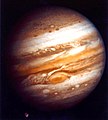Fichier:Jupiter gany.jpg

Taille de cet aperçu : 538 × 600 pixels. Autres résolutions : 215 × 240 pixels | 431 × 480 pixels | 673 × 750 pixels.
Fichier d’origine (673 × 750 pixels, taille du fichier : 114 kio, type MIME : image/jpeg)
Historique du fichier
Cliquer sur une date et heure pour voir le fichier tel qu'il était à ce moment-là.
| Date et heure | Vignette | Dimensions | Utilisateur | Commentaire | |
|---|---|---|---|---|---|
| actuel | 15 octobre 2023 à 12:17 |  | 673 × 750 (114 kio) | 0x0a | offcial JPG, more details |
| 16 février 2016 à 10:19 |  | 970 × 1 081 (281 kio) | PlanetUser | black bg | |
| 15 mars 2015 à 06:20 |  | 970 × 1 081 (72 kio) | Jcpag2012 | larger (with auto correction) from TIFF file | |
| 22 février 2015 à 07:24 |  | 758 × 858 (238 kio) | Jcpag2012 | processing | |
| 9 novembre 2004 à 06:14 |  | 758 × 858 (58 kio) | Gentgeen | {{PD-USGov-NASA}} |
Utilisation du fichier
La page suivante utilise ce fichier :
Usage global du fichier
Les autres wikis suivants utilisent ce fichier :
- Utilisation sur af.wikipedia.org
- Utilisation sur ar.wikipedia.org
- Utilisation sur be.wikipedia.org
- Utilisation sur bg.wikipedia.org
- Utilisation sur cs.wikipedia.org
- Utilisation sur en.wikipedia.org
- Utilisation sur en.wiktionary.org
- Utilisation sur es.wikipedia.org
- Utilisation sur et.wikipedia.org
- Utilisation sur eu.wikipedia.org
- Utilisation sur gu.wikipedia.org
- Utilisation sur he.wikipedia.org
- Utilisation sur hi.wikipedia.org
- Utilisation sur hr.wikipedia.org
- Utilisation sur hr.wiktionary.org
- Utilisation sur hy.wikipedia.org
- Utilisation sur id.wikipedia.org
- Utilisation sur it.wikipedia.org
- Utilisation sur it.wiktionary.org
- Utilisation sur ja.wikipedia.org
- Utilisation sur ja.wiktionary.org
- Utilisation sur kbp.wikipedia.org
- Utilisation sur la.wikipedia.org
- Utilisation sur mdf.wikipedia.org
- Utilisation sur mk.wikipedia.org
- Utilisation sur ml.wikipedia.org
- Utilisation sur mr.wikipedia.org
- Utilisation sur mwl.wikipedia.org
- Utilisation sur nl.wikipedia.org
- Utilisation sur no.wikipedia.org
- Utilisation sur pl.wikiquote.org
- Utilisation sur ps.wikipedia.org
Voir davantage sur l’utilisation globale de ce fichier.



